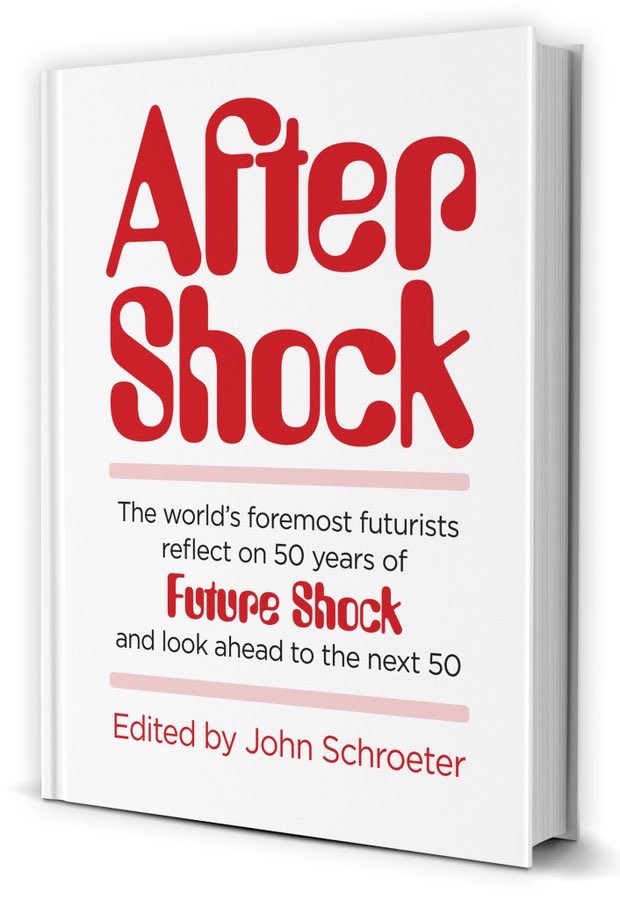50 years after the publication of Alvin Toffler’s landmark book “Future Shock“, a new book “After Shock” is here. This 540-page compendium collects over 100 modern-day perspectives on After Shock from leading futurists, including deep assessments of Toffler’s formidably prescient predictions from half a century ago, along with a status check on the current exponential growth (“shock”) in all sectors of the world economy, from the unique vantage points of many different contributors. Contributors include David Brin, Po Bronson, Sanjiv Chopra, George Gilder, Newt Gingrich, Alan Kay, Ray Kurzweil, Jane McGonigal, Lord Martin Rees, Byron Reese, and many others. I am honored to be included among those luminary contributors. I present here a short excerpt from my contribution to the book.

“Shocking Amount of Data”
An excerpt from my chapter in the book:
“We are fully engulfed in the era of massive data collection. All those data represent the most critical and valuable strategic assets of modern organizations that are undergoing digital disruption and digital transformation. Advanced analytics tools and techniques drive insights discovery, innovation, new market opportunities, and value creation from the data. However, our enthusiasm for “big data” is tempered by the fact that this data flood also drives us to sensory input shock and awe.
“Among the countless amazing foresights that appeared in Alvin Toffler’s Future Shock was the concept of information overload. His discussion of the topic came long before the creation and proliferation of social networks, the World Wide Web, the Internet, enterprise databases, ubiquitous sensors, and digital data collection by all organizations—big and small, public and private, near and far. The clear and present human consequences and dangers of infoglut were succinctly called out as section headings in Chapter 16 “The Psychological Dimension” of Toffler’s book, including these: “the overstimulated individual,” “bombardment of the senses” and “decision stress.”
“While these ominous forecasts have now become a reality for our digitally drenched society, especially for the digital natives who have known no other experience, there is hope for a lifeline that we can grasp while swimming (or drowning) in that sea of data. And that hope emanates from the same foundation that is the basis of the information overload shock itself. That foundation is data, and the hope is AI – artificial intelligence. The promise of AI is entirely dependent on the flood of sensory input data that fuels the advanced algorithms that activate and stimulate the Actionable Insights (representing another definition of A.I.), which is what AI is really aimed at achieving.
“AI is a great producer of dichotomous reactions in society: hype versus hope, concern versus commercialization, fantasy versus forward-thinking, overstimulation versus overabundance of opportunity, bombardment of the senses versus bountiful insights into solving hard problems, and decision stress versus automated decision support. Could we imagine any technology that has more mutually contradictory psychological dimensions than AI? I cannot.
“AI takes its cue from data. It needs data – and not just small quantities, but large quantities of data, containing training examples of all sorts of behaviors, events, processes, things, and outcomes. Just as a human (or any cognitive creature) receives sensory inputs from its world through multiple channels (e.g., our five senses) and then produces an output—make a decision, take an action—in response to those inputs, similarly that is exactly what an AI does. The AI relies on mathematical algorithms that sort through streams of data, to find the most relevant, informative, actionable, and pertinent patterns in the data. From those presently perceived patterns, AI then produces an output (decision and/or action). For example, when a human detects and then recognizes a previously seen pattern, the person knows how to respond—what to decide and how to act. This is what an AI is being trained to do automatically and with minimal human intervention through the data inputs that cue the algorithms.
“How AI helps with infoglut and thereby addresses the themes of Toffler’s writings (“information overload”, “overstimulation and bombardment of the senses”, and “decision stress”) is through…
…”
You can continue reading my chapter, plus dozens more perspectives, in the full After Shock book here: https://amzn.to/2S01MC7

